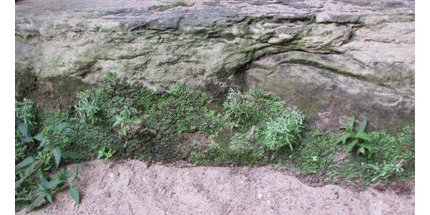The Soil Science Society of America had its North American Societies Conference (Canada/Mexico/US combined societies) in San Diego this month - https://www.sacmeetings.org/
1,700 people came and gave talks. Lots of talks!!! You can review the topics covered by various categories, such as mineralogy, soil chemistry, microbiology, fire impacts on soil, climate change, soil physics, irrigation management, etc, etc, etc -
https://scisoc.confex.com/scisoc/2019sssa/meetingapp.cgi/ModuleProgramBook/0
or by what was presented each day -
https://scisoc.confex.com/scisoc/2019sssa/meetingapp.cgi/ModuleSessionsByDay/0
It's a huge amount of information. By clicking on the session, its possible to see the different speakers and topics and see an abstract of the talk. For example, clicking on the Monday, 9:30 AM session on Fire in the Landscape:
reveals a bunch of talks
https://scisoc.confex.com/scisoc/2019sssa/meetingapp.cgi/Session/18403
clicking on the 11 AM talk by Jeff Hatten gives:
24-7 Fire Effects on Soil Organic Matter in a Southern Appalachian Hardwood Forest: Connecting the Movement of Fire-Altered Organic Matter in Soil and Aquatic Systems'. Jeff A. Hatten1, Lauren Matosziuk2, Adrian Gallo1, Katherine Heckman3, Kevin D. Bladon4, Lucas E. Nave5, Brian D. Strahm6, Tyler Weiglein7, Jessie Egan8, Maggie Bowman9 and Ryan Stewart10, (1)Department of Forest Engineering, Resources and Management, Oregon State University, Corvallis, OR, (2)Oregon Sate University, Corvallis, OR, (3)Northern Research Station, USDA Forest Service (FS), Houghton, MI, (4)Department of Forest Engineering, Resources, and Management, Oregon State University, Corvallis, OR, (5)University of Michigan Biological Station, Pellston, MI, (6)310C Cheatham Hall (0324), Virginia Tech, Blacksburg, VA, (7)310 West Campus Dr., Virginia Tech, Blacksburg, VA, (8)University of Colorodo Boulder, Boulder, CO, (9)INSTAAR, University of Colorado Boulder, Boulder, CO, (10)Crop and Soil Environmental Sciences, Virginia Tech, Blacksburg, VA
And clicking on the title will give the abstract : 24-7 Fire Effects on Soil Organic Matter in a Southern Appalachian Hardwood Forest: Connecting the Movement of Fire-Altered Organic Matter in Soil and Aquatic Systems'.
Fire can have dramatic effects on the quantity and quality of soil organic matter (SOM). While combustion of the O-horizon causes direct losses of SOM, fire also transforms the remaining SOM into a spectrum of thermally altered organic matter. This spectrum ranges from hydrophilic, low molecular weight compounds to highly condensed, hydrophobic carbon (i.e., black carbon and PAHs). These compounds have differing mobility in the environment, and thus their impacts on soils and aquatic systems vary by their mobility. The objectives of this study are to Examine the fate and mobility of 1) particulate and hydrophobic compounds such as black carbon and PAHs and 2) hydrophilic compounds in soil and aquatic dissolved organic matter. Studying the effects of wildfire is always challenging due to the rapid post-fire changes to the environment and lack of robust controls. We overcame those limitations by examining the Chimney Tops 2 Fire which burned 4,617 ha of the Great Smokey Mountain (GRSM) National Park, a National Ecological Observatory Network (NEON) site, in November 2016. We have examined soils from three-time points from an area burned a low-severity (pre-, immediate post-, and 11 months post-fire) and two-time points from areas burned at low to high severity (immediate post-, and 11 months post-fire). These soil profiles have been examined for black carbon and PAH contents. We are currently collecting information on the mobile phases of soil and aquatic organic matter. Here, we will present preliminary data from a study examining the effects of fire on the movement of thermally altered dissolved carbon in soils. All samples have a high concentration of black carbon, and as a result, we could not detect a change in black carbon as a result of a low-severity fire. All profiles showed that the proportion of carbon as black carbon increased with depth to about 10cm and remained constant, suggesting that black carbon is being turned over at a slower rate than other forms of carbon at depth. Samples collected along a severity gradient showed that severity and time-since fire affected the black carbon content. We have evidence that the majority of black carbon missing from the surface soils (i.e., ash bed) has moved into the top 5cm of mineral soil. We expect that the hydrophobic PAHs will follow a similar pattern as black carbon. Overall, we intend for this information to facilitate a thorough examination of the effect of fire on the relative flux of carbon through soil profiles and into aquatic systems.
So, this is how some organic matter moves through the soil after a fire. It doesn't all go up into the air as carbon dioxide, some of it actually migrates deeper into the soil and will probably persist there for a long long time.
Or maybe the whole issue of what constitutes a Healthy Soil interests you? Check out these talks:
https://scisoc.confex.com/scisoc/2019sssa/meetingapp.cgi/Session/18511
Read more about similar and different presentations at the Conference. The full papers based on the abstracts will be out at some later date once they have been properly reviewed for accuracy. That usually takes several months to get all of these presentations organized.
